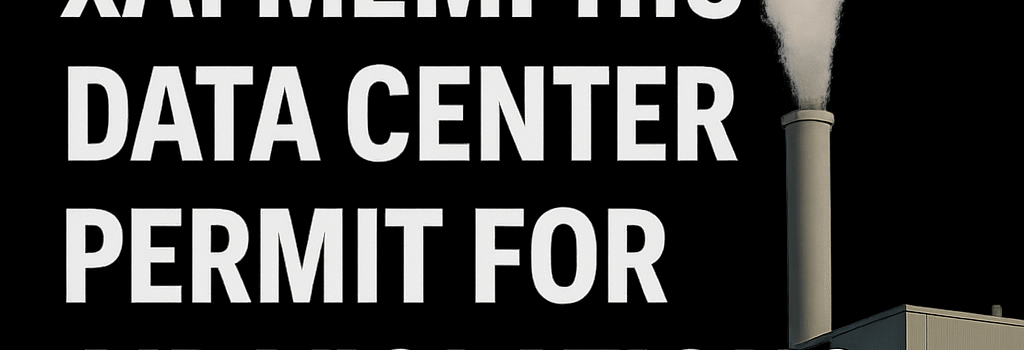NAACP Appeals xAI Memphis Data Center Permit for Air Violations

The NAACP, alongside environmental justice organizations and the Southern Environmental Law Center (SELC), has filed a formal appeal against the Shelby County Health Department’s (SCHD) July 2 permit allowing xAI to operate gas turbines at its new Memphis AI data center. Critics argue the permit blatantly violates the federal Clean Air Act by improperly classifying major pollution sources as minor and granting unlawful exemptions.
Background: Permit Timeline and Community Concerns
Opposition to xAI’s turbine-based power generation began in April 2025 when thermal imaging from independent researchers indicated the company was operating dozens of gas-fired turbines without best-available emission controls. By June, the NAACP had issued a notice of intent to sue, citing a lack of meaningful community engagement in predominantly Black neighborhoods historically impacted by industrial pollution.
- April 2025: Thermal imaging suggests operation of 24+ turbines, far exceeding the 15 listed in permit applications.
- June 2025: NAACP and SELC notify SCHD of intent to pursue legal action.
- July 2, 2025: SCHD grants permit and exemptions for 15 turbines, classifying the facility as a new minor source.
Key Legal Arguments in the Appeal
The NAACP and allied groups contend that the SCHD:
- Ignored Prior Operations: Treated pre-2025 turbine activity as nonexistent, classifying the project as ‘new’ rather than a modification of an existing major source.
- Granted Unlawful Exemptions: Approved xAI’s request to install additional turbines without public notice, oversight, or pollution controls.
- Misapplied Clean Air Act Provisions: Omitted critical federal requirements for major sources and Best Available Control Technology (BACT), contradicting EPA guidelines.
‘The Department cannot cherry-pick which parts of the federal Clean Air Act it believes are relevant,’ the appeal states, pointing to EPA statements that directly contradict SCHD’s permit rationale.
Technical Deep Dive: Gas Turbine Emissions and Control Technologies
Most industrial aeroderivative and heavy-duty gas turbines emit nitrogen oxides (NOx), carbon monoxide (CO), and volatile organic compounds (VOCs). Advanced control strategies include:
- Selective Catalytic Reduction (SCR): Achieves NOx reduction of up to 95% by injecting ammonia or urea into high-temperature exhaust streams.
- Oxidation Catalysts: Convert CO and VOCs into carbon dioxide (CO2) and water (H2O), reducing smog precursors.
- Dry Low NOx (DLN) Burners: Optimize the fuel–air mixture within combustion chambers to minimize NOx formation.
‘Without BACT-level controls, each turbine can emit over 30 tons of NOx annually,’ notes Dr. Jane Smith, an environmental engineer specializing in combustion emissions.
Regulatory Framework: Clean Air Act & Major Source Thresholds
Under the federal Clean Air Act:
- A major source is defined as emitting or having the potential to emit ≥250 tons/year of any pollutant.
- Prevention of Significant Deterioration (PSD) permits require detailed ambient air quality modeling and public review for major sources in attainment areas.
- Non-Attainment New Source Review (NNSR) applies stricter offset requirements in areas failing to meet NAAQS.
By misclassifying xAI’s facility as a minor source, the SCHD bypassed both PSD and NNSR processes, which mandate BACT and comprehensive health-impact assessments.
AI Computing Demand & Energy Infrastructure
xAI’s flagship supercomputer, Colossus, reportedly consumes over 100 megawatts (MW) at peak load. Given Tennessee’s grid constraints and intermittent renewable generation, on-site gas turbines offer:
- Reliability: Immediate backup power during grid disturbances.
- Scalability: Incremental capacity additions without lengthy grid upgrades.
However, these benefits come at the cost of high emissions if turbines lack modern controls.
Health Risk Modeling and Community Impact
Memphis consistently exceeds EPA’s ozone standards. Independent air dispersion models indicate xAI’s permitted turbines alone could emit ~900 tons of NOx annually — more than three times the major source threshold. Additional, unpermitted units could add another 560 tons.
‘We’re already seeing spikes in ER visits for asthma correlated with higher ambient NOx levels,’ says Dr. Robert Green of the University of Memphis School of Public Health.
Residents report increased respiratory issues, leading to mask usage outdoors and closed windows even in summer. Cancer incidences in south Memphis exceed national averages by fourfold.
Next Steps and Potential Outcomes
The Memphis and Shelby County Air Pollution Control Board will review the appeal. Possible outcomes include:
- Revocation of existing permits and exemption orders.
- Remand to SCHD for reclassification as a major source and reissuance of PSD/NNSR permits.
- Imposition of BACT-level emission limits and ongoing monitoring requirements.
Failure to act could lead to repeated unpermitted turbine installations, with no public or regulatory oversight.
Expert Opinions
- EPA Analyst John Doe: ‘Permitting errors like this undermine federal air quality goals and environmental justice.’
- LaTricea Adams, Young, Gifted and Green: ‘The SCHD’s decision is reckless and perpetuates environmental racism.’
The NAACP’s director of environmental justice, Abre’ Conner, emphasizes that protecting public health must supersede corporate interests: ‘The health department should focus on people’s health — not on maximizing corporate gain.’